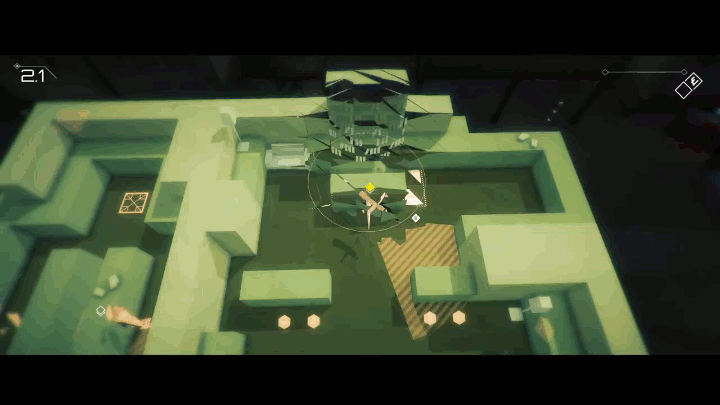Volume review: Stealth distilled in Mike Bithell's witty and elegant indie gem

Volume
Platforms: PS4 (tested), PS Vita, PC
Developer: Bithell Games
Publisher: Bithell Games
Release Date: Out now
If Volume makes one thing clear, it's that the career trajectory of developer Mike Bithell is one of the most interesting in video games. He made his name with unassuming but eminently charming indie platformer Thomas Was Alone in 2010, and has now followed up that success with his take on the stealth genre.
First released as a Flash-based browser game, Thomas Was Alone arrived on PC in 2012, on PlayStation devices in 2013 and on phones, tablets and the current crop of consoles in 2014. It was a success well beyond Bithell's wildest expectations, but the allure of a sequel never tempted him. Instead, he sought to develop the game he'd always wanted to make, Volume – his difficult second album.
On the surface all that's shared between Volume and Thomas Was Alone is voice actor Danny Wallace, but conceptually they have much in common. Thomas boiled down the platforming genre defined by Mario and his ilk to its most base elements, a minimalist approach that grew naturally in depth and challenge as the player progressed. Volume does the same for stealth.
Bithell's influences are lovingly worn on the game's sleeves. Metal Gear Solid's VR missions inspire a great deal of the gameplay and colourful aesthetic, but there's also a large dollop of Pac-Man in the level-layout and jewels to be collected.
Volume's story is a sci-fi retelling of the Robin Hood legend. It follows Robert Locksley, a young man who finds a device – called the Volume – which allows him to create holographic, augmented reality spaces. He uses it to recreate real-world locations and simulate heists targeting a wealthy and oppressive ruling class. Locksley, with AI partner Alan, broadcasts these simulations online as how-tos to inspire the downtrodden to rise up and take their country back from England's ruthless ruler Guy Gisborne, who runs the country as a corporatocracy.

One hundred "core" missions tell the story with additional missions courtesy of user-created stages shared online. Story missions typically take a few minutes to complete, lending the game the moreish, "just one more" quality of a mobile title.
The bite-size nature of levels, the par times begging to be met and a worldwide leaderboard for each makes replaying them a delight. Limitless user-generated content – created in a nifty but somewhat daunting tool – only strengthens the game's longevity.
Where Volume delights – like Thomas – is in its systems and how they're introduced. At first the player is simply avoiding the vision cones of patrolling guards, but over the course of most of those 100 levels, new gadgets, enemy types, obstacles and hiding methods are brought in at a pace that never overwhelms the player. There is always the means to test these new facets of the game comfortably, a design tic which evokes Nintendo's Super Mario franchise – the very pinnacle of this kind of design.
Inconsistent logic at the apex of Volume's game mechanics and story are problematic. Locksley is teaching people how to conduct various heists in the real world, but often within his simulations getting caught en route to the level's end marker is a necessity. Reaching that marker, or any checkpoint, cancels out the danger of being caught. In the case of checkpoints, getting caught and killed will reset you at that point with whatever items you picked up before being spotted.
Shadowy areas are also used to lure guards, who cannot see you in those areas even it is a single square in the middle of a room. In the case of most guards, even standing directly at their feet in these areas doesn't alert them. Such moments are infrequent but feel like cheating, cheapening the experience of conquering a level.

If Volume were purely a mechanics-based game these problems would scarcely matter, but they clash with the story being told. That story, on the whole, is pretty good and told in such a way that rarely gets between the player and play. Bithell's script, like that of Thomas, is ceaselessly witty and never afraid to poke at the fourth wall, if not break it down entirely.
Protagonist Locksley is played by YouTuber Charlie McDonnell – a fitting piece of casting given the game is essentially about a young man making Let's Play videos, just ones being used to inspire revolution not pass time. His performance is unfortunately bland however, a likelihood given his lack of acting experience. Thankfully Danny Wallace, as Alan, is in fine form once again and Andy Serkis, as Gisborne, basically phones it in but Serkis phoning it in is still fairly good.
There are grand total of two cut scenes marking the midpoint and end of the core levels, each showing evidence of a stretched budget The rest of the story is told with dialogue over gameplay, documents read during levels and through the character's whose homes and places of work you're virtually infilitrating. These characters are never fleshed out with dialogue and have only tarot card-like names such as The Banker, The Deposed Queen and The Murderer. Their stories are told through the descriptions of each level and help flesh out the world of Volume beyond the simulations.
However, almost by default, narrative really takes a back seat in Volume, such is the strength of its gameplay. A larger budget and loftier ambitions may make it less of the pure experience Thomas Was Alone was, but it is inventive, well-designed and above-all fun proof that Mike Bithell is far from a one-hit wonder.

For all the latest video game news follow us on Twitter @IBTGamesUK.
© Copyright IBTimes 2025. All rights reserved.






















